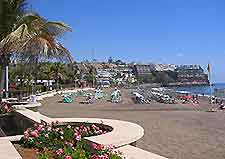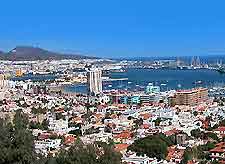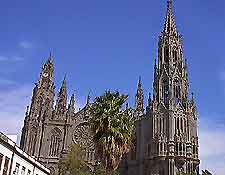Gran Canaria Neighborhoods, Locations, Towns and Villages
(Gran Canaria, Canary Islands, Spain)

Gran Canaria is one of the most visited of the Canary Islands and has a combined population of more than 700,000, comprising a number of cities, towns, villages and districts. Often known for its tremendous variation in both climate and landscape, Gran Canaria offers many places of interest and some truly spectacular coastlines.
Las Palmas de Gran Canaria, the island's capital city, has long been an important part of local life and is full of everything that you would expect in a big city, including fine dining, shopping and hotels, together with nearby beaches and water sports.
The historic town of Arucas is close to Las Palmas Gran Canaria and is best known for its stunning views of the northern coastline. Other notable towns and villages on the island include Gáladar - famous for being home to the ancient Cueva Pintada (Painted Cave), Telde - the second-largest city on Gran Canaria, and the Maspalomas area, with a high concentration of restaurants, nightspots and beaches, including the Playa del Inglés.

Las Palmas de Gran Canaria
With a true feeling and character of a big city, Las Palmas is the capital of Gran Canaria and contains a high concentration of shops along the Calle Mayor de Triana, many to restaurants and fine dining opportunities, and numerous hotels throughout the city, together with a busy port. Situated on the northeastern coast, Las Palmas dates back to the 15th century and is home to a population of around 360,000, making it the seventh-biggest city in the whole of Spain. With a historic centre, nearby beaches - including the spectacular Playa de las Canteras, and a number of notable museums, despite its size, Las Palmas is full of traditional Spanish character.
Much of Las Palmas de Gran Canaria is divided into districts and regions, including the southerly old historical centre - with many notable buildings; the Triana and Vegueta districts - full of sightseeing opportunities, restaurants and stylish architecture; and Santa Catalina - known for its beachfront hotels, business hub and sandy coastline, stretching for around 3 km / 2 miles. Nearby, the Puerta de la Luz is a major port, responsible for much of the island's wealth over the years. Nearby and further north you will find La Islete, which was once a small islet and is now connected to Las Palmas.
Top tourist attractions in the city of Las Palmas include the Catedral de Santa Ana, the 16th-century Castillo de la Luz, the Museo Canaria, the Museo Néstor, the Parque San Telmo and the Jardin Botanico Canario Viera y Clavijo. Water sports are also in plentiful supply around the Las Palmas coastline, including surfing, scuba diving and snorkelling.
Artenara
Gran Canaria's highest village, Artenara is close to Tejeda and offers impressive views. Many of the houses in Artenara have been built into the rock faces, including a cave church and a number of troglodyte caves, where small groups of people still live today.

Arucas
A busy town often known as the 'pearl of Gran Canaria', Arucas is full of things to see and do. Home to many notable buildings and structures, including the historic Neo-Gothic Iglesia de San Juan, the contemporary town hall (ayuntamiento), the Neo-classical Heredad de Aguas de Arucas y Firgas building, and the Plaza Constitución, Arcuas is a popular excursion from nearby Las Palmas. Other attractions in Arucas include the landscaped municipal gardens, and the La Montana de Arucas area, which offers spectacular scenic views across the island's northern coastline.
Gáladar
The small town of Gáladar has a population of around 24,000 and is home to one of Gran Canaria's most significant ancient treasures, the Cueva Pintada (Painted Cave). With ancient drawings painted by the Guanches many years ago, this area is now both a museum and archaeological park, known as the Museo Etnografico de Barranco Hondo de Abajo.
Ingenio and Agüimes
Located to the south of Telde, Gran Canaria's towns of Ingenio and Agüimes are connected by regular bus transport, being separated by the Barranco de Guayadeque (Guayadeque Ravine). With appealing town centres, most people choose to visit Agüimes, which offers a central plaza area, seasonal festivals and the Iglesia de San Sebastian church, with eye-catching architecture highly regarded throughout the island.
Playa del Inglés / Maspalomas
Boasting around 350 bars and restaurants, the Playa del Inglés is one of the island's most desirable beach resorts and contains a golden sandy coastline, which stretches for around 8 km / 5 miles. Known as the party end of the island, the Maspalomas area lies of the southern side of Gran Canaria and contains many enormous hotel complexes and vast swimming pools, with the Playa del Inglés being situated in the very heart of the resort, close to the Yumbo Centum shopping centre. Many major tourist attractions and theme parks can be found in and around the Maspalomas area, including Palmitos Park, the Aqua Sur water park, the Camel Safari Park La Baranda, and Holiday World - with roller coasters, fast riding and a 'laserdrome'. Both surfing and windsurfing are also popular along the surrounding coastline of Maspalomas, and the Playa del Inglés is known for its lively nightlife and gay clubs.
San Bartolomé de Tirajana
Although you will find no particularly notable tourist attractions or sights in and around San Bartolomé de Tirajana, this charming village offers spectacular views across the Tirajana Valley and contains a number of inexpensive hotels and restaurants, particularly along the Calle Tamaran. San Bartolomé de Tirajana has a population of around 4,000 and is located in an elevated spot.
Santa Lucia de Tirajana
Santa Lucia de Tirajana can be found close to the very heart of Gran Canaria, near to the villages of Fataga, Taidia and Temisas, standing next to San Bartolomé de Tirajana. A particularly attractive spot, with views across the valley, many mature palm trees, and white-washed houses, highlights here include a domed church and the Castillo de la Fortaleza - a Disney-style castle filled with Guanche artefacts and tools.
Santa Maria de Guia
Home to a population of just under 10,000 people, Santa Maria de Guia stands around 25 km / 16 miles to the west of Las Palmas de Gran Canaria and is often known locally as simply 'Guia'. With a beautiful 17th-century church, the town features a famous festival each September, La Rama de las Marias, where locals dance to the church and offer gifts to the Virgin Mary.
Telde
The second-biggest city of the island of Gran Canaria, Telde has a population of around 100,000 and is steeped in history, with the San Francisco and San Juan districts being located in the heart of the main Old Town area. Telde is situated just 12 km / 7 miles from Las Palmas and contains a number of notable old buildings, including the 15th-century Basilica de San Juan, which is known for its stunning altarpiece and impressive architecture. Also worth a mention, the striking Iglesia de San Francisco is close to the Plaza San Juan, with a popular walk nearby along the cobble street of Calle Inés Chandia, which passes a historic aqueduct, scenic orange groves and other exotic plantations. One of the most popular museums in this part of Gran Canaria is the Casa Museo León y Castillo, celebrating the life of famous local architect Fernando de León y Castillo and also displaying many local treasures.
Temisas
Well connected by public transport, Temisas is easy to reach along the C-815 Highway and is a quiet and appealing village, containing a wealth of old stone houses set against a magnificent backdrop of cliff faces. With a number of terraced areas and plenty of sights for visitors, Temisas is a peaceful and scenic part of Gran Canaria and a popular excursion from both nearby Santa Lucia de Tirajana and Agüimes, being located between the two towns.
Teror
Home to a population of around 7,000 and a location just 22 km / 14 miles to the southwest of Las Palmas de Gran Canaria, Teror is a small town centered around the attractive Plaza Nuestra Senora del Pino. The intersecting street of Calle Real is lined with historic residences and buildings, such as the Casa de los Patronos de la Virgen, which has become an important local museum. One of the main landmarks within the Teror area is the 18th-century Basilica de la Virgen del Pino, featuring Neo-classical architecture and an elaborate interior.
 Gran Canaria is one of the most visited of the Canary Islands and has a combined population of more than 700,000, comprising a number of cities, towns, villages and districts. Often known for its tremendous variation in both climate and landscape, Gran Canaria offers many places of interest and some truly spectacular coastlines.
Gran Canaria is one of the most visited of the Canary Islands and has a combined population of more than 700,000, comprising a number of cities, towns, villages and districts. Often known for its tremendous variation in both climate and landscape, Gran Canaria offers many places of interest and some truly spectacular coastlines.
